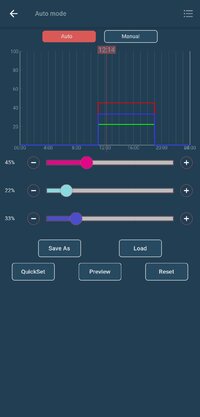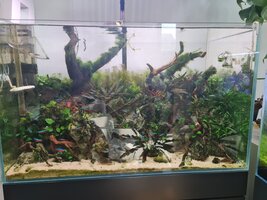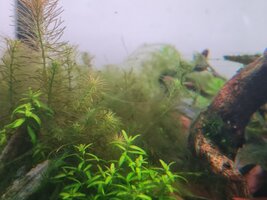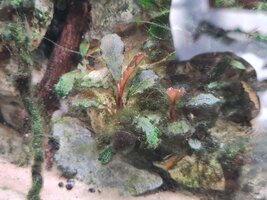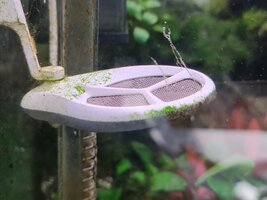Epiphyte
Member
I've been trying to rid my tanks of algae for about as long as I've had them set up. I think my issue is Spirogyra and I cannot fix it.
1. Size of tank in litres.
ADA 75p, approx 150L
2. Age of the set - up.
3 months
3. Filtration.
Oase Biomaster Thermo 600 full of Seachem Matrix
APS Surface Skimmer
Twinstar Reactor (not a filter I know)
UV Filter
4. Lighting and duration.
Chihiros Vivid 2 RGB, approx 35-40% power, 8 hours
5. Substrate.
Tropica with ADA Bottom Plus
6. Co2 dosing or Non-dosing.
In line CO2 diffuser, 4hr before lights to 1hr before lights off. Nice light green drop checker
7. Fertilizers used & Ratios.
2hr Aquarist APT 2 Complete - 4ml a day in accordance to bottle instructions.
8. Water change regime and type.
50% weekly, RO water re-mineralised to TDS 120 using Salty Shrimp GH/KH+
9. Plant list + When planted.
Myriophyllum Guyana
Rotala Wallichii
Pearl Weed
Lots of Anubias
Lots of Buce
Lots of Crypts
Lots of Alternanthera Reineckii "Mini"
Lots of Fissidens
Various terrestrial Pothos cuttings have been recently introduced
10. Inhabitants.
Approx 25 Cardinal Tetra
M/F Nannacara pair
M/F Apistogramma pair
8 Otto's
A single Siamese Algae Eater (his buddies thought they'd try flying, unsuccessfully)
An unknown number of Amano Shrimp
Nerite Snails and a never ending population of ramshorn snails, kept somewhat in check by a vicious female Apisto.
- I feed one cube of "super fish tropical mix" frozen food a day to the the tank, I don't believe I am over-feeding but I'm happy to be proven wrong.
I have just cleaned the tank out best I can manually with todays water change so I'm unable to get a picture of the tank with the algae on show. I believe it is spirogyra as it's a dark green filamentous algae which doesn't just grow off things, flowing in the water stream (I have some of that algae and it's easy enough to deal with) but it clogs everything, plants are utterly swamped by it sometimes, especially around the rhizome area of epiphytes, in the mosses and in the fine leaves of the stem plants. When you go to remove it it really clings to what it is attached to, it cannot be syphoned up. A toothbrush removes it fairly well but it's nearly impossible to get it all especially with the delicate nature of the stems. Removing it from epiphytes has actually pulled the plant away from the wood (using super glue to bond it) before I've been able to pull the algae off.
I've tried dosing the tank with glutaraldehyde daily but it doesn't seem to make the slightest of difference. I've spot dosed APT Fix (which works wonders on BBA by the way, highly recommended), I've reduced the lights, increased the lights, nothing. I just get the feeling that once it's in my tank it's doing it's best to stay there with the slightest bit left over.
Plants are growing well, new epiphyte growth, stems are needing regular trims. I've had floating plants in the tank a few times in and out but I hate the look and if I'm honest, it didn't seem to make any difference apart from to stifle the growth of the stems where the bunched in the corner of the tank. I've recently taken cuttings of a beautiful Neon Golden Pothos which I'm trying to propagate in the tank which I hope will suck up all the nasties when they grow, but this is yet to happen as they're only a few weeks old in the water and it's a painfully slow process.
Any help would be massively appreciated from those who may have defeated this awful algae as I'm about to lose the will to live with this tank. I'll try get photos soon.
1. Size of tank in litres.
ADA 75p, approx 150L
2. Age of the set - up.
3 months
3. Filtration.
Oase Biomaster Thermo 600 full of Seachem Matrix
APS Surface Skimmer
Twinstar Reactor (not a filter I know)
UV Filter
4. Lighting and duration.
Chihiros Vivid 2 RGB, approx 35-40% power, 8 hours
5. Substrate.
Tropica with ADA Bottom Plus
6. Co2 dosing or Non-dosing.
In line CO2 diffuser, 4hr before lights to 1hr before lights off. Nice light green drop checker
7. Fertilizers used & Ratios.
2hr Aquarist APT 2 Complete - 4ml a day in accordance to bottle instructions.
8. Water change regime and type.
50% weekly, RO water re-mineralised to TDS 120 using Salty Shrimp GH/KH+
9. Plant list + When planted.
Myriophyllum Guyana
Rotala Wallichii
Pearl Weed
Lots of Anubias
Lots of Buce
Lots of Crypts
Lots of Alternanthera Reineckii "Mini"
Lots of Fissidens
Various terrestrial Pothos cuttings have been recently introduced
10. Inhabitants.
Approx 25 Cardinal Tetra
M/F Nannacara pair
M/F Apistogramma pair
8 Otto's
A single Siamese Algae Eater (his buddies thought they'd try flying, unsuccessfully)
An unknown number of Amano Shrimp
Nerite Snails and a never ending population of ramshorn snails, kept somewhat in check by a vicious female Apisto.
- I feed one cube of "super fish tropical mix" frozen food a day to the the tank, I don't believe I am over-feeding but I'm happy to be proven wrong.
I have just cleaned the tank out best I can manually with todays water change so I'm unable to get a picture of the tank with the algae on show. I believe it is spirogyra as it's a dark green filamentous algae which doesn't just grow off things, flowing in the water stream (I have some of that algae and it's easy enough to deal with) but it clogs everything, plants are utterly swamped by it sometimes, especially around the rhizome area of epiphytes, in the mosses and in the fine leaves of the stem plants. When you go to remove it it really clings to what it is attached to, it cannot be syphoned up. A toothbrush removes it fairly well but it's nearly impossible to get it all especially with the delicate nature of the stems. Removing it from epiphytes has actually pulled the plant away from the wood (using super glue to bond it) before I've been able to pull the algae off.
I've tried dosing the tank with glutaraldehyde daily but it doesn't seem to make the slightest of difference. I've spot dosed APT Fix (which works wonders on BBA by the way, highly recommended), I've reduced the lights, increased the lights, nothing. I just get the feeling that once it's in my tank it's doing it's best to stay there with the slightest bit left over.
Plants are growing well, new epiphyte growth, stems are needing regular trims. I've had floating plants in the tank a few times in and out but I hate the look and if I'm honest, it didn't seem to make any difference apart from to stifle the growth of the stems where the bunched in the corner of the tank. I've recently taken cuttings of a beautiful Neon Golden Pothos which I'm trying to propagate in the tank which I hope will suck up all the nasties when they grow, but this is yet to happen as they're only a few weeks old in the water and it's a painfully slow process.
Any help would be massively appreciated from those who may have defeated this awful algae as I'm about to lose the will to live with this tank. I'll try get photos soon.




